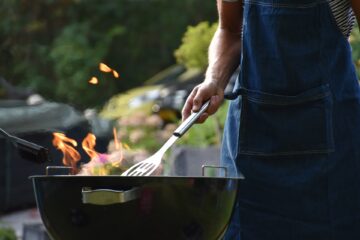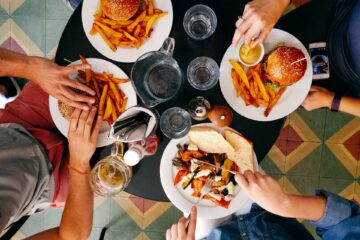If you have ever cooked with alcohol, you may have wondered how much of the alcohol actually remains in the finished dish. In this article, we will explore the science behind alcohol evaporation during cooking and discuss the factors that affect the amount of alcohol that remains in your food. So, let’s dive in!
Understanding Alcohol Evaporation in Cooking
When you cook with alcohol, the heat causes the alcohol to evaporate, and this process changes the texture, flavor, and aroma of your dish. But how much of the alcohol content is left after cooking? Understanding the science behind alcohol evaporation is crucial for cooking dishes with alcohol and for people who are avoiding alcohol for health or personal reasons.
The amount of alcohol that remains after cooking depends on several factors, such as cooking time, temperature, and the amount of alcohol you use. Knowing how these factors affect alcohol evaporation can help you adjust your cooking techniques and ingredient choices to suit your needs. In this article, we’ll take a closer look at alcohol evaporation in cooking and explore how much alcohol is left in your food after cooking.
How Much Alcohol is Cooked Off?
When cooking with alcohol, it’s common to wonder how much of it will remain in the dish after cooking. The amount of alcohol that is cooked off depends on several factors, including the cooking method, temperature, and cooking time.
Studies have shown that the longer you cook with alcohol, the more of it will evaporate. However, even after hours of cooking, there may still be a small amount of alcohol remaining in the dish.
The percentage of alcohol that is cooked off can also vary depending on the type of alcohol used. For example, wine typically has a lower alcohol content than spirits like whiskey or vodka, so less alcohol will evaporate during cooking. On the other hand, a higher-proof spirit will cook off more alcohol than a lower-proof one.
It’s also important to note that some cooking methods, such as flambéing, can actually increase the alcohol content in a dish, as the flames burn off the alcohol and leave behind a concentrated residue.
Overall, it’s difficult to determine exactly how much alcohol is cooked off during the cooking process, as it depends on a variety of factors. However, using a recipe that calls for a specific amount of alcohol can help ensure that you’re not adding an excessive amount to your dish.
Factors That Affect Alcohol Evaporation
Alcohol evaporation during cooking can be influenced by several factors. One of the most significant factors is the cooking time and temperature. The longer and hotter the cooking process, the more alcohol will evaporate. For example, if you simmer a sauce for an extended period, more alcohol will evaporate than if you cook it on high heat for a shorter period.
The type of alcohol used in the recipe also plays a role in evaporation. Alcohols with lower boiling points, like gin and white wine, will evaporate more quickly than those with higher boiling points, such as whiskey and brandy. Additionally, the alcohol content in the recipe affects evaporation. A dish with a higher alcohol content will take longer to evaporate than a dish with less alcohol.
The surface area of the dish can also impact evaporation. The more surface area exposed to the heat, the quicker the alcohol will evaporate. For example, a shallow pan will cause more alcohol to evaporate than a deep pot.
Finally, stirring the dish during cooking can speed up the evaporation process. This is because stirring increases the surface area and exposes more of the alcohol to the heat. However, over-stirring can also cause the alcohol to evaporate too quickly, resulting in a dry dish.
Cooking with Alcohol: Tips and Tricks
Cooking with alcohol can add depth and complexity to many dishes, from savory sauces to sweet desserts. Here are some tips and tricks to keep in mind when cooking with alcohol:
- Choose the Right Alcohol: Different types of alcohol can add different flavors to your dishes. For example, red wine works well in beef stews, while white wine is great for seafood and poultry dishes. Brandy and cognac can add a rich, warm flavor to desserts.
- Add Alcohol Early in the Cooking Process: To allow time for the alcohol to evaporate and the flavors to meld, it’s best to add alcohol early in the cooking process. For example, when making a risotto, add the wine after the onions have cooked but before the rice is added.
- Use a Low Heat: When cooking with alcohol, it’s important to use a low heat to prevent the alcohol from evaporating too quickly. This will give the flavors time to develop and blend.
- Don’t Overdo It: While alcohol can add great flavor to dishes, it’s important not to overdo it. Too much alcohol can overpower other flavors in the dish and make it unpalatable. As a general rule, start with a small amount and add more gradually if needed.
- Consider Substitutes: If you don’t want to use alcohol in your cooking, there are some substitutes you can use. For example, you can use chicken or vegetable broth in place of white wine in a recipe.
- Be Mindful of Alcohol Content: Even if most of the alcohol has evaporated during cooking, some may still remain. If you’re cooking for someone who cannot have any alcohol, be sure to choose a recipe that does not contain any or adjust the recipe accordingly.
By keeping these tips in mind, you can add alcohol to your cooking with confidence and create flavorful and delicious dishes.
Conclusion
In conclusion, the amount of alcohol that is cooked off can vary depending on several factors such as the cooking time, temperature, and method used. It is important to note that even though alcohol evaporates during cooking, there may still be trace amounts remaining in the dish. For those who want to avoid alcohol completely, there are alternative ingredients that can be used to achieve similar flavors. However, for those who enjoy cooking with alcohol, it is important to be mindful of the amount being used and to understand the effects of cooking on the alcohol content.




